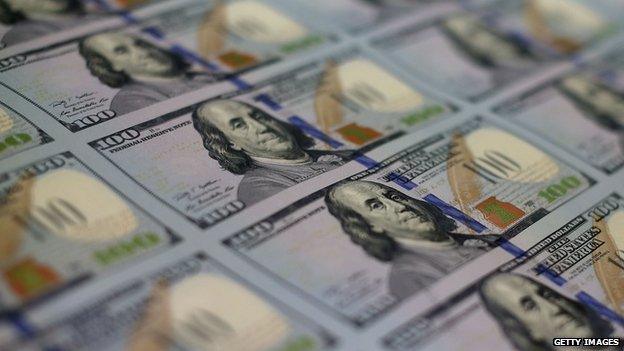Dollar flourishes as emerging market currencies struggle
- Published
- comments

From the South African rand to the Brazilian real to the euro, currencies are weakening to the lowest levels in over a decade against the dollar.
The dollar, measured against a basket of its trading partners, has reached the highest level since 2003 - the last time that it traded at parity with the euro.
Of course, it's not just the dollar strength. Currencies trade in pairs, so it also partly has to do with the euro's slide as the European Central Bank launched quantitative easing, or QE, for the first time on Monday.
The weakening of emerging-market currencies also reflects structural weaknesses such as large external deficits which were last highlighted during the so-called "taper tantrum" a couple of summers ago.
That was when the Fed first hinted that its QE programme would end, and investors left the economies that were seen as risky and returned to safer destinations to park their money.
US rates
With the US economy improving, the Fed is expected to raise rates, probably this year.
That would mean a higher return to money invested in dollars than say in the euro, which is weakening its currency by injecting cash.
So, there are parallels, but the rout in emerging market currencies and the euro isn't raising alarm bells about potential balance of payments crises like it was then.
For one, the external deficits of some of the big emerging economies have improved. Within the so-called fragile five economies that were considered at risk of a crisis, India's current account has improved substantially and Turkey has too.
Cheaper commodity prices have helped, which is a key difference between 2013 and now. Oil prices plunging and other commodities also dropping in price have helped not just inflation but also reduced the trade deficit.
Commodities challenged
But, the reverse side of that is the commodity exporters.

Brazil and South Africa are facing outflows of capital as their currencies have respectively hit their lowest levels in 11 and 13 years.
Indonesia's growth is also affected since commodities account for two-thirds of exports and the rupiah had hit its lowest level since 1998, which was the tail-end of the Asian financial crisis.
Divergent monetary policies only complicate the picture.
From China to South Korea, 17 central banks have cut interest rates this year to boost their economies.
Investors are also anticipating a rate rise in the US, so the gap makes the dollar even more attractive.
And these emerging markets largely continue to peg to the dollar, so their exports are losing competitiveness too.
Euro gloom
As for the euro, continuing tensions over Greece make it a less attractive place for investors.
Well, the periphery at least. The core countries have seen demand push their bond yields into negative territory.
Even Italy's benchmark borrowing cost has hit a record low. In any case, a weaker euro may be welcomed by eurozone exporters who have seen the euro retain its strength throughout the past few years due to Germany, despite the euro crisis.
So, the rate rise anxieties are certainly felt but it's not a repeat of the summer of 2013. For now, currencies are adjusting but without massive upheavals.
But, it is a reminder of the influence of the US central bank over the global economy still.